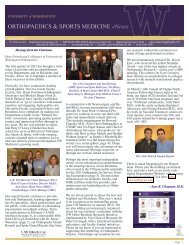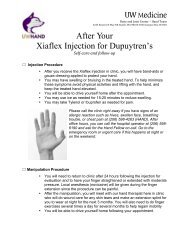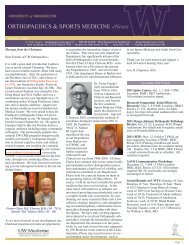2002 - University of Washington Bone and Joint Sources
2002 - University of Washington Bone and Joint Sources
2002 - University of Washington Bone and Joint Sources
Create successful ePaper yourself
Turn your PDF publications into a flip-book with our unique Google optimized e-Paper software.
Accuracy <strong>and</strong> Reproducibility <strong>of</strong> Step <strong>and</strong> Gap Measurements<br />
from Plain Radiographs After Intra-Articular Fracture <strong>of</strong> the<br />
Distal Radius<br />
WREN V. MCCALLISTER, M.D., JEFFREY M. SMITH, M.D., JEFF KNIGHT, B.S.,<br />
AND THOMAS E. TRUMBLE, M.D.<br />
Recent reports have highlighted<br />
the important relationship<br />
between residual intra-articular<br />
displacement <strong>and</strong> the long-term<br />
outcome <strong>of</strong> distal radius fractures.<br />
There appears to be a general consensus<br />
that accelerated development <strong>of</strong><br />
arthritis <strong>and</strong> worsened severity <strong>of</strong><br />
degenerative changes is associated with<br />
residual step-<strong>of</strong>f displacements greater<br />
than 1 to 2 millimeters. Therefore, to<br />
improve clinical outcome after intraarticular<br />
fracture <strong>of</strong> the distal radius,<br />
many reports in the literature strongly<br />
advocate surgical reduction <strong>of</strong><br />
fragments with articular incongruities<br />
greater than 1 to 2 millimeters. In each<br />
<strong>of</strong> these studies, the intra-articular step<strong>of</strong>f<br />
<strong>and</strong> gap displacements were<br />
measured in millimeters using plain<br />
radiographs.<br />
Definitive st<strong>and</strong>ards for describing<br />
<strong>and</strong> quantifying articular surface<br />
incongruity do not exist. Kreder et al.<br />
in 1996 attempted to st<strong>and</strong>ardize the<br />
technique for measuring intra-articular<br />
displacement <strong>of</strong> distal radius fractures.<br />
Sixteen observers examined six<br />
radiographs <strong>of</strong> healed intra-articular<br />
distal radius fractures <strong>and</strong> found that,<br />
“…even experienced clinicians did not<br />
readily agree on the size <strong>of</strong> step <strong>and</strong> gap<br />
deformity.” Specifically, they found that<br />
two experienced observers chosen at<br />
r<strong>and</strong>om to measure step-<strong>of</strong>f <strong>and</strong> gap<br />
displacement would differ by 3<br />
millimeters or more at least 10% <strong>of</strong> the<br />
time, while the same observer making<br />
repeat measurements would be<br />
expected to differ by 2 millimeters at<br />
least 10% <strong>of</strong> the time. Singer also<br />
demonstrated significant interobserver<br />
variability in the measurement <strong>of</strong> intraarticular<br />
distal radius fracture fragment<br />
displacement using plain radiographs.<br />
To date, the accurate <strong>and</strong> reliable<br />
measurement <strong>of</strong> intra-articular fracture<br />
displacements <strong>of</strong> less than 2 millimeters<br />
from plain radiographs has not been<br />
established.<br />
The purpose <strong>of</strong> this study was to<br />
determine the accuracy <strong>and</strong><br />
reproducibility <strong>of</strong> measured step-<strong>of</strong>f<br />
<strong>and</strong> gap displacements involving the<br />
articular surface <strong>of</strong> the distal radius.<br />
Our hypothesis was that step-<strong>of</strong>f <strong>and</strong><br />
gap displacements <strong>of</strong> 2 millimeters or<br />
less would show poor accuracy <strong>and</strong><br />
reproducibility for both intra- <strong>and</strong><br />
inter-observer measurements. This<br />
study differs from others in that by<br />
using cadaver specimens, we have<br />
created a gold st<strong>and</strong>ard for the fracture<br />
displacements. Earlier studies, lacking<br />
such a gold st<strong>and</strong>ard, were limited to<br />
comparisons among observers <strong>and</strong><br />
could not comment on the accuracy <strong>of</strong><br />
measurement. Further, our cadaver<br />
model mimics intra-articular fracture<br />
in the acute setting. As Kreder et al.<br />
acknowledge, “It may well be that some<br />
parameters (such as step <strong>and</strong> gap<br />
deformity) are more readily quantified<br />
in the acute setting, since fracture lines<br />
have not been obscured by the healing<br />
process.” Finally, by computing<br />
tolerance limits, we attempt to define a<br />
reliable threshold for the accuracy <strong>and</strong><br />
reliability <strong>of</strong> plain film radiography in<br />
the setting <strong>of</strong> intra-articular distal<br />
radius fractures. Such information has<br />
value to the clinician in the decisionmaking<br />
process regarding the use <strong>of</strong> CT<br />
imaging.<br />
METHODS<br />
A Melone three-part fracture was<br />
created in cadaver forearms to generate<br />
a total <strong>of</strong> 12 combinations <strong>of</strong> step <strong>and</strong><br />
gap displacement (Figure 1). The range<br />
<strong>of</strong> step deformity was 3.5mm (0.5 min,<br />
4.0 max) <strong>and</strong> the range <strong>of</strong> gap<br />
deformity was 3.9mm (0.1 min, 4.0<br />
max). The radiographs were examined<br />
by 22 physicians (divided into three<br />
groups based on skill level: Group 1: six<br />
R1 <strong>and</strong> R2 level orthopaedic surgery<br />
residents; Group 2: four R4 senior<br />
orthopaedic surgery residents on the<br />
H<strong>and</strong> service, five H<strong>and</strong> Fellows; Group<br />
3: six experienced Attending h<strong>and</strong><br />
surgeons <strong>and</strong> one musculoskeletal<br />
radiologist) in a blinded, r<strong>and</strong>omized<br />
fashion using a st<strong>and</strong>ardized technique.<br />
Twice each physician (range 3 weeks to<br />
Step-<strong>of</strong>f<br />
Gap<br />
Inter Intra Inter Intra<br />
ICC * 0.78 0.81 0.85 0.89<br />
κκ ** 0.64 0.65 0.65 0.76<br />
Tolerance (mm) 2.58 1.76 2.51 1.61<br />
Table 1: Results for inter- <strong>and</strong> intra-observer measurements (see Methods for explanation). * L<strong>and</strong>is & Koch agreement criteria: 0.80 almost perfect.<br />
<strong>2002</strong> ORTHOPAEDIC RESEARCH REPORT 25















